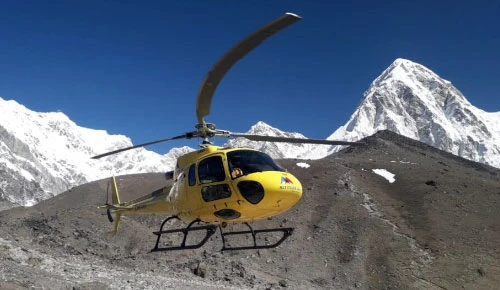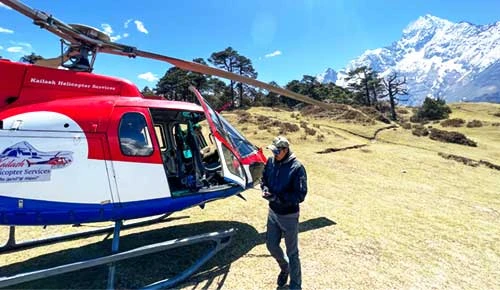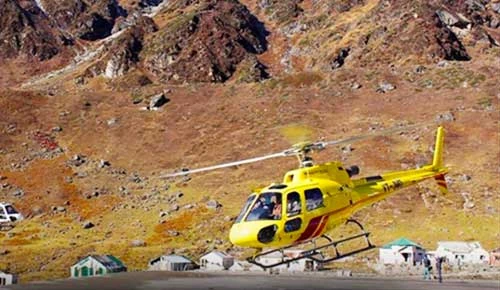Evolution and Popularity of Mount Everest Helicopter Tour
Everest Base Camp, which is in the Himalayas, has long been a destination for adventurers who want to climb Mount Everest, the highest peak in the world. In the past, the journey was a hard trek through rough terrain and changing weather that took weeks to get to the main camp. However, the introduction of helicopter tours has revolutionized the way in which people experience this iconic location.
In this blog, we look at how Everest Base Camp helicopter flights have changed over time and how popular they have become. We also talk about what this means for travelers and the environment.
Table of Contents
History of Helicopters in Nepal
Helicopters have played a significant role in Nepal due to its challenging terrain and limited road infrastructure. The introduction of helicopters in Nepal can be traced back to the mid-20th century. In the early days, helicopters were mainly used for emergency medical evacuation (medevac), search and rescue operations, and transporting supplies to remote areas.
The Royal Nepalese Army Air Service (now known as the Nepal Army Air Service) acquired its first helicopter, a Hiller UH-12E, in 1961. This marked the beginning of helicopter operations for various purposes in Nepal. Over the years, the Nepal Army Air Service has expanded its fleet and capabilities, using helicopters for both military and civilian purposes.
Here is a brief history of helicopters in Nepal.
Decades | Key developments and roles |
1960s | Initial helicopter use for royal tours and search and rescue. |
1970s | Expansion of helicopter operations, aiding development, and tourism. |
1980s | Continued support for development, tourism, and disaster response. |
1990s | Humanitarian, military, and disaster relief roles. |
2000s | Modernization, safety enhancements, and high-altitude rescues. |
2010s and ongoing | Ongoing search, rescue, transport, and medical evacuations. |
The Early Days: Emergence of Helicopter Tour
For decades, the only way to reach Everest Base Camp was through trekking, a physically demanding and time-consuming journey. The introduction of helicopter tours added a new dimension to this adventure. For those who had time or physical limitations, it offered an alternative.
As early as the 1970s, helicopters began flying into the Khumbu region, offering a unique opportunity to witness the Himalayan grandeur from above. At first, helicopters were only used for emergency evacuation or to supply goods and medicines in the Himalayas.
These initial attempts at helicopter tours faced challenges like high-altitude operations and unpredictable weather, but they paved the way for what would become a burgeoning industry.
Technological Advancements
Advancements in aviation technology have played a pivotal role in the growth of the Everest helicopter tour. Specialized helicopters equipped with powerful engines, advanced navigation systems, and enhanced safety features have made high-altitude flights safer and more efficient. The development of these helicopters has not only expanded the accessibility of Base Camp but has also offered travelers a safe and comfortable way to experience the Himalayan splendor.
Unique Selling Points of Helicopter Tour
Helicopter tours to Everest Base Camp boast a range of unique selling points that set them apart from traditional trekking. The most compelling of these is the unparalleled aerial perspective that helicopter travel affords.
Here are the unique selling points of a helicopter tour:
- Aerial Perspective: Helicopter tour offer a stunning aerial view of the Himalayas, showcasing snow-covered peaks, valleys, and glaciers.
- Time Efficiency: What used to take weeks on foot can now be done in a few hours by helicopter, making it ideal for those with limited time or physical abilities.
- Convenience: Helicopter tours remove the need for challenging treks, allowing everyone to appreciate Everest's beauty without strain.
- Luxurious Experience: Travelers enjoy modern helicopters, attentive service, and the intimacy of small group settings,which provide both comfort and exploration.
Environmental and Cultural Considerations
As the popularity of helicopter tours grows, so does the need to address the environmental and cultural implications. The delicate ecosystem of the Himalayas is particularly vulnerable to human activity, and the increased frequency of helicopter flights raises concerns about noise pollution, air quality, and disturbance to local wildlife. By using eco-friendly practices and adhering to flight paths that have less impact on sensitive areas, tour operators are making an effort to reduce their ecological footprint.
Furthermore, helicopter tours have brought both opportunities and challenges to the local Sherpa communities. While they benefit from increased tourism and economic opportunities, there is a delicate balance to strike between welcoming visitors and preserving their cultural heritage. Collaborative efforts between tour operators, local communities, and conservation organizations are essential to ensuring that the positive impact of tourism is sustainable in the long term.
Popularity Surge: Factors Driving Demand
The popularity of helicopter tours to Everest is driven by a confluence of factors. The modern traveler seeks experiences that are both unique and Instagram-worthy. The allure of soaring above the world's highest peaks and capturing this surreal beauty on camera has sparked interest among adventure enthusiasts and casual tourists alike. The influence of social media has undoubtedly played a role in turning this once-in-a-lifetime experience into a bucket-list item for many.
Additionally, the rise in adventure tourism, where seeking the extraordinary is paramount, has contributed to the appeal of helicopter tours. Unlike traditional treks, helicopter tours offer a sense of exclusivity, catering to those who desire an adventure without sacrificing comfort.
Future Trends and Sustainability
The future of helicopter tours lies in striking a balance between technological innovation and environmental responsibility. As technology continues to advance, helicopters will become more efficient, quieter, and eco-friendly. Efforts to reduce emissions, adopt green technologies, and implement responsible flying practices are likely to become industry standards. Collaborative efforts between tour operators, local communities, and environmental organizations will be essential to ensuring that the benefits of helicopter tourism are sustained for future generations.
Conclusion
Discover a whole new way to experience the magnificence of the Himalayas with our Mount Everest helicopter tour. Our tour is designed to offer you a unique perspective on this iconic region. By harnessing advancements in helicopter technology, we bring you closer to the awe-inspiring beauty of Everest than ever before.
Imagine taking in the breathtaking aerial views as you glide over the Himalayan peaks, valleys, and glaciers. Our helicopter tour not only provides stunning vistas but also saves you precious time. What once required weeks of trekking can now be experienced in just a few hours, making it accessible to all, regardless of physical limitations or time constraints.
We understand the importance of responsible tourism and are committed to preserving the natural splendor and cultural heritage of the Everest region. As you go on this remarkable journey, you become a part of this preservation effort.
So, whether you're an adventure seeker or someone who simply wants to witness the majesty of Everest in comfort, our Mount Everest Base Camp Helicopter Touroffers an unforgettable experience. Join us in embracing the spirit of exploration while contributing to the sustainable future of this incredible destination. Book your Everest helicopter tour with us today and be a part of this remarkable adventure!








